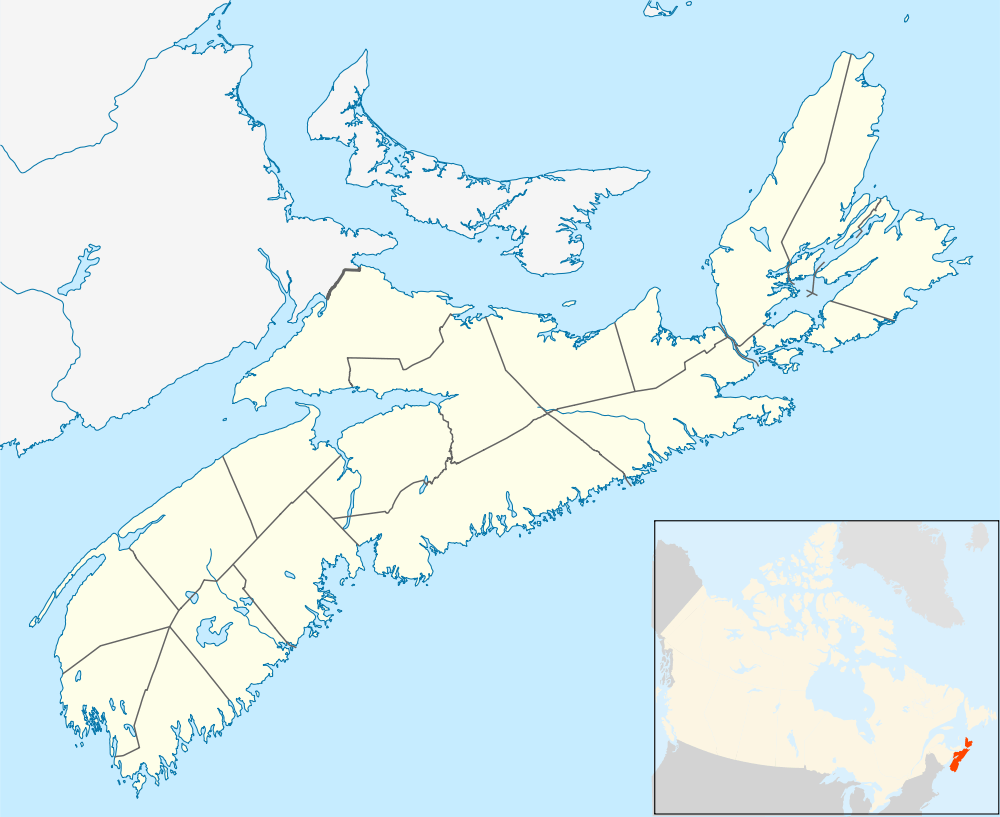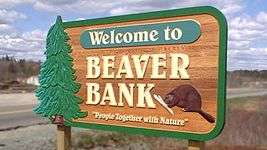Beaver Bank, Nova Scotia
| Beaver Bank | |
|---|---|
|
The sign of Beaver Bank as you enter | |
| Motto: "People Together with Nature" | |
| Coordinates: 44°48′07″N 63°41′17″W / 44.80194°N 63.68806°W | |
| Country |
|
| Province |
|
| Municipality | Halifax Regional Municipality |
| Community council | North West Community Council |
| District | 14 - Middle/Upper Sackville - Beaver Bank - Lucasville |
| Founded in | 1776 |
| Government | |
| • MP for Sackville—Eastern Shore | Darrell Samson (Lib) |
| • Mayor of Halifax | Mike Savage |
| • MLA for Waverley-Fall River-Beaver Bank | Bill Horne (Lib) |
| • Councillor of Middle/Upper Sackville - Beaver Bank - Lucasville | Brad Johns |
| Population (as of 2011) | |
| • Total | 7,119 [1] (est.) |
| Time zone | AST (UTC-5) |
| • Summer (DST) | ADT (UTC-4) |
| Postal Code | B4E, B4C, B4G |
| Area code(s) | 902 |
| Website | http://www.beaverbank.ca/ |

Beaver Bank (2011 population: 7,119) is a suburban community northeast of Lower Sackville on the Beaver Bank Road (Route 354) within the Halifax Regional Municipality, Nova Scotia, Canada. It is about 35 kilometres from the City of Halifax.
History
The community of Beaver Bank dates back to 1776 when Loyalists from Boston John Henry Barnstead (1764–1861) and his mother, Mary Brown Parcel Barnstead, arrived there. After the War of 1812 George and John Barrett, shopkeepers from Blackthorn, Oxford, England. In 1816, the Fultz family were granted a thousand acres (4 km²) of land. A museum bears their name in nearby Lower Sackville.
Other long standing families of this area include:
- Lively, the descendants of Reuben Lively ( 1756-1826), member of the 96th District. An American loyalist from South Carolina, he was granted 500 acres in the Rawdon Township after the American Revolutionary War in 1784.
- Shunamon (Schöenmann), descendants of Carl Ludwig Schöenmann (1740-1820) of Eisfeld, Germany. A former Hessian soldier in the American Revolutionary War, he arrived in Beaver Bank prior to or during the year 1813.
- Among the oldest family names are Dean, Langille, Gilby, Peters, Woods and Nicholson.
GROVE FAMILY The Grove Family offers a rich contribution to Beaver Bank history. Originally from England, the siblings moved to Nova Scotia after living in Philadelphia for several years. The four Grove sisters quickly established a reputation in Halifax due to their prestigious finishing school in the Downtown area. They were described once as, "Those four English sisters whose ability and character influenced for good so large a number of young ladies of that generation." Woodlands, the Grove residence, was built in Beaver Bank in 1847. The two Grove brothers lived on the property, profiting from saw-milling, brick-making, farming and box-making. In 1880 their sisters returned, and established the Grove School for Young Ladies in its place, which ran until destroyed by fire in 1943. One or all of the Grove sisters is/are the writer(s) of what is thought to be the first piece of children's literature written in Nova Scotia, possibly even Canada, titled Little Grace or Scenes in Nova Scotia. The original book still remains with the Grove family to this day.. The sisters also are the main influence behind the construction of the first Anglican Church in Beaver Bank, in 1886: The Church of the Good Shepard. The Original church was sold in 1998 to a private buyer and removed from its foundation and its proper standing place. Today is it located in the township of Chester and used for private purposes. Frances Shunamon (McCarron, née Grove) donated the land in her newly developed "Shunamon Subdivision" to house the newer and current Church of the Good Shepard, which still stand today.
Beaver Bank Station
When the Canadian Railway reached Sackville in the mid-1850s under direction of Joseph Howe, the first Chief Commissioner of the Nova Scotia Railway Company, the next step was to construct a station and freight shed. The Beaver Bank Station served the Sackville/Beaver Bank area until 1956, creating business opportunities for lumbermen by shipping to Halifax.
Daniel Hallisey, of County Cork, Ireland, was one of the builders of the original railway. He became the first Station Master. In 1856 he built a house/hotel next to the station, which many say served more as a tavern than anything. The house offered the new assets of a telegraph and post office, which ran for 99 years. Sir Robert Borden was often present at this house for entertainment.
Today, the Beaver Bank Station building remains at the corner of the Beaver Bank Road and Windgate Drive (formerly known as the Windsor Junction Crossroad). It had been converted into a pub called the Black Crow, which closed. In early 2014, construction began on the building to renovate and re-open it to the public. On July 11, 2014, the building re-opened as the Beaver Bank Station, a pub/restaurant.
Beaver Bank "Radar"
RCAF Station Beaver Bank was a long-range Pinetree Line early warning radar station operated by the Royal Canadian Air Force, located in Beaver Bank.
RCAF Station Beaver Bank was approximately 40 km (25 mi) north of Halifax-Dartmouth. The station sat on 430 acres (1.7 km²) with about a half a mile (800 m) separation between the domestic and the operations site; both sites being divided by the county line between Halifax County (domestic site) and Hants County (operations site).
The "22 Aircraft Control & Warning Squadron" was the operational unit posted to the station, its colours having been created in 1953 and the unit made operational a year later in the fall of 1954. The radar unit itself was manually operated and reported to the Fredericton NORAD Sector at RCAF Station St. Margarets until September 1962 when this was changed to the Bangor NORAD Sector at Topsham AFS, Maine.
The 22 AC&W became SAGE-operational on January 1, 1964; however, this capability did not last long as the station was closed and the squadron disbanded four months later on April 1, 1964, following a NORAD realignment and increasing focus being placed on the DEW Line. After the closure of the base, it had been used briefly as a cement factory.
Royal Canadian Air Force (RCAF) Station Beaver Bank occupied a unique location in proximity to Canada's largest Atlantic seaport and its biggest naval base, making it an important early warning radar during the manual environment of the 1950s. Since manned bomber raids by the Soviet Union in the area were considered quite likely, it was felt that RCAF Station Beaver Bank fulfilled a critical role in the early days of Canada's and North America's air defence. The station was originally financed by the United States Air Force, although operational responsibility rested with the RCAF, until 1962 when the RCAF assumed financial responsibility as well. In the mid-1970s the base was converted for a short time to a cement plant. This was only used for a few years before the base was abandoned completely.
Early entertainment
Residents of Beaver Bank in the 1950s had close access to the First Sackville Drive-In Theatre, and the Sackville Downs Raceway (now Downsview area, Sackville Drive).
Spelling
Beaver Bank is often misspelled as "Beaverbank" as it was misprinted on provincial signs for much of the 1980s and 1990s. After the community rallied together in protest for many years, the province re-issued the signs with the correct spelling. There are still some signs in the province have not been fixed.
As some early texts such as newspapers spelled Beaver Bank as one word, many of the older residents still consider that spelling to be correct.
Facilities and businesses
Convenience stores
- Chen's Convenience (formerly Yohanna's Variety) - As Yohanna's Variety this store was featured in the television series Trailer Park Boys in Season 1 Episode 1. It is located on cross-section between Beaver Bank Road and Woodbine Drive (recently renamed Welkin Drive).
- Beaver Bank Guardian Pharmacy - located near Beaver Bank Pizza - 309 Beaver Bank Road.
- Hartlen's Wilsons (formerly Hartlen's Esso) - located in Northern Beaver Bank, approximately two miles past Kinsac.
- Joey's Convenience & Video - located on the corner of Tucker Lake Road. Building was condemned in September 2015 and the store is no longer in business.
Restaurants
- Beaver Bank Pizza - located on the cross-section between Beaver Bank Road and Woodbine Avenue.
- Foosing Chinese Restaurant - located before the Beaver Bank Pharmacy.
Golf
- Lost Creek Golf Club: an 18-hole championship golf course within a residential community - located in Lost Creek Subdivision.
- Emerson Ridge Driving Range - Located across from the Beaver Bank Brown Hall and ches Variety Store on the Beaver Bank Road.
Facilities
- Beaver Bank Community Hall (Brown Hall) - located across from Emerson Driving Range and beside Chen's Variety Store.
- Beaver Bank Community Centre - located on the Beaver Bank Road beside the Beaver Bank Kinsac Volunteer Fire Department, in front of Beaver Bank Kinsac Elementary School. Re-opened 24 November 2012.
- Ivy Meadows Continuing Care Facility (formerly Scotia Nursing Homes Ltd.) - 51 bed nursing facility, located 15 km on the Beaver Bank Road from Sackville Drive.
Emergency facilities
- Beaver Bank Volunteer Fire Department - located beside the Beaver Bank Community Centre, on the Beaver Bank Road.
- Beaver Bank Dispatch - located on the Beaver Bank Road; beside Beaver Bank Kinsac Volunteer Fire Department.
Camps and day care facilities

- Harold T. Barrett Fun Forest Camp - located on the Beaver Bank Road, past Kinsac. Beaver Bank Lake south of camp. property of 2nd Beaver Bank Scouting Group.
- First Memories Daycare - located on the Beaver Bank Road beside Woodbine Mobile Home Park.
- Peachtree Children's Centre - located at 971 Windgate Drive (formerly known as Windsor Junction Cross Road). Located inside of Crossroads Wesleyan Church beside the Black Crow Pub.
- Rachael's Daycare - located in Rivendale subdivision near Beaver Bank Monarch Elementary School.
- Beaver Bank Homework Club - located off Beaver Bank Road - Opened its doors March 2015 - Welcomes children K to 9.
Residential areas
Mobile home parks
- Woodbine Mobile Home Park - located on the Beaver Bank Road. Population of 2,512 (estimate). Roughly 628 trailers/mobile homes.
Subdivisions
- Greenforest Subdivision - located beside Barrett Lake.
- Barrett Subdivision - located just past Harold T. Barrett Junior High School.
- Monarch/Rivendale Subdivision - located near Beaver Bank Monarch Drive Elementary School and Majestic Avenue.
- Lost Creek Subdivision - located near Tucker Lake.
- Shunamon Subdivision - located between Grove Avenue and Barrett Subdivision.
- Lakeridge Estates - located just past the Beaver Bank-Kinsac Ball field, off the Beaver Bank Road.
- Davis Subdivision - located in North Beaver Bank, shortly after Lakeridge Estates
Schools
Elementary schools
- Beaver Bank - Kinsac Elementary School - Grades K-6
- Beaver Bank Monarch - Drive Elementary School - Grades K-6
Junior high schools
- Harold T. Barrett Junior High School - Grades 7-8
High schools
- Lockview High School - In Fall River - Grades 9-12
- Sackville High School - In Lower Sackville - Grades 9-12
- Millwood High School - In Lower Sackville - Grades 9-12
References
- ↑ "Community Counts Home Page". Government of Nova Scotia.
- Harvey, Robert P., Images of Our Past: Historic Sackville
External links
- Beaver Bank on Destination Nova Scotia
- HRM Civic Address Map
- Beaver Bank - Kinsac Elementary School
- Beaver Bank - Monarch Drive Elementary School
- Harold T. Barrett Junior High School
- Beaver Bank Official Site
- 2nd Beaver Bank Scouting Group
- The Brown Hall
Coordinates: 44°48′07″N 63°41′17″W / 44.80194°N 63.68806°W
